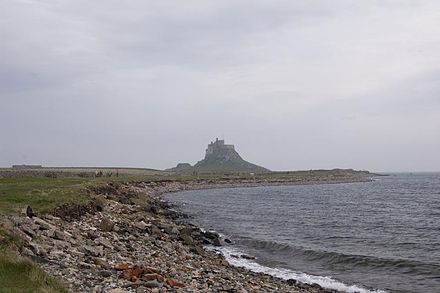Lindisfarne - tidal island in North East England
The Holy Island of Lindisfarne, known colloquially as either Lindisfarne or Holy Island, is just off the coast of Northumberland, England. It is a tidal island linked to the mainland by a causeway.
The monastery of Lindisfarne was raided by Vikings in AD 793. This event is usually considered to mark the beginning of the Viking Age.
Get in
Access to Lindisfarne is affected by tides. This point cannot be stressed enough as many people get stranded on the causeway every year requiring coastguard rescue (sometimes including helicopter rescue). Tide tables are available locally and are published on the internet, such as the tables published by Northumberland County Council.
By bus
Local bus service 477 runs from nearby Berwick-upon-Tweed, however it can be somewhat irregular due to tidal patterns, and does not run every day through winter months. Travellers are advised to make local enquiries before making arrangements around the bus service.
There is also a H1 service operated by Travelsure, which runs from Belford, and connects to their route 418 to Alnwick via Alnmouth (for rail connections), Seahouses and many other villages along the Northumberland coast. Again, this has an irregular timetable to take into account tide times and therefore again travellers should seek advice from those with local knowledge where possible.
By car
The main east coast road, the A1, is convenient for Lindisfarne. The turning is in the small village of Beal (which appears to consist only of The Plough Hotel and a service station, both on the eastern side of the road). The turning is signed as "Holy Island". The distance from the turning to the island is approximately 5 miles, including the tidal causeway.
On foot
The Pilgrim's Crossing is a clearly marked walking route from the mainland to the island that crosses the sand and mud. However, due to the tidal nature of this crossing, it is strongly advised that this route must only be attempted with an experienced local guide.
Get around
Due to its size and nature, Lindisfarne has very few roads. Those that exist tend to be narrow and often have tourists walking on them. There is a large car park before the settlement on the island. The car park is pay & display, priced at £3.50 for under 3 hours, with 3 to 24 hours costing £5.50 (as of August 2019). On-street parking is virtually non-existent. Some B&Bs may offer parking; however, this should be checked when booking.
From the car park there is a shuttle bus to the castle, although visitors need to check if this will be running on the day of their visit. Beyond this and the bus link from the mainland, there is no public transport on the island.
In essence, be prepared to do some walking. Maps are available on the island, including a number of suggested circular routes.
See

- Lindisfarne Priory, TD15 2RX, 55.669964°, -1.800675°, +44 1289 389200. Apr-Sep: daily 10AM-6PM; Oct: daily 10AM-5PM; Nov-Mar: Sa Su 10AM-4PM. Founded by St Aidan, Lindisfarne's Priory's most famous "resident" is St Cuthbert; although he now lies in Durham Cathedral. The nearby museum gives further information on St Cuthbert and the development of the Priory. The Priory and museum are in the custodianship of English Heritage. Check the website for information of special events. Adults £5.40, children £3.20, concessions £4.90 2020-04-21
- Lindisfarne Castle, TD15 2SH, 55.6698°, -1.78756°, +44 1289 389244, lindisfarne@nationaltrust.org.uk. Opening times vary due to tides, either 10AM-3PM, 10AM-4PM, noon-5PM, or 11AM-5PM. The 16th-century Tudor castle, later converted into an Edwardian home is situated high on a rocky crag, affording good views of the island, Bamburgh Castle and the surrounding North Sea (weather permitting) The castle is a National Trust property. £8 2019-09-01
- Get up early to watch the sunrise. Go to the hill at the south end of the island overlooking the priory grounds; you get an excellent view of the sunrise behind the castle. It's fantastic when there are rolling sea mists as well.
Do
Birdwatching. Large parts of the Island as well as the adjacent intertidal areas are protected for wildlife as part of the Lindisfarne national nature reserve. It main purpose is to safeguard the wintering bird population. Over 300 species have been recorded on the island and adjacent tidal flats. The Brent Goose, Widgeon and Teal are particularly note worthy.
Seal spotting. Grey seals can sometimes be seen on the beaches during high tide.
Eat
Drink
Sample the local meade, which is an alcoholic drink made by fermenting honey.
Sleep
Lindisfarne has a number of small Bed & Breakfast establishments, a couple of small hotels and pubs offering accommodation.
- Manor House Hotel, Market Square, 55.66988°, -1.80117°, +44 1289 389207.
- Lindisfarne Hotel, 55.6720°, -1.8005°, +44 1289 389273.
- Belvue Guesthouse, Chare Ends, Holy Island, Northumberland, TD15 2SE (Belvue Guesthouse is the seventh on your left, house after you pass the main Holy Island car park), 55.673178°, -1.801084°, +44 1289 389500, info@holy-island.uk. Check-in: 3:30PM, check-out: 10:30AM. Launched in 2019 Belvue guesthouse offers three rooms: two high end studios with kitchenette and a no frills twin room. All rooms have en suite showers. £79-145 2019-06-25
Stay safe
Check the tide tables carefully – otherwise you can get caught on the island or, as some unfortunates have – on the causeway itself. The tide table is available from the Lindisfarne website (although all tide times should be treated as advisory and local weather can affect the tides). Note that your motorhome does not double as a boat.
Connect
As of June 2022, Lindisfarne has a basic mobile signal from Three, and 4G from EE, O2 and Vodafone; this extends along the causeway and lane to A1. 5G has not reached this area.
Go next
- North to Berwick upon Tweed
- South to Amble, Alnmouth and Alnwick
Lindisfarne
England
Primary administrative division